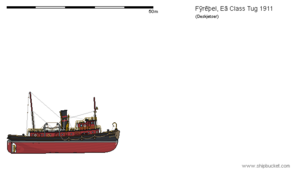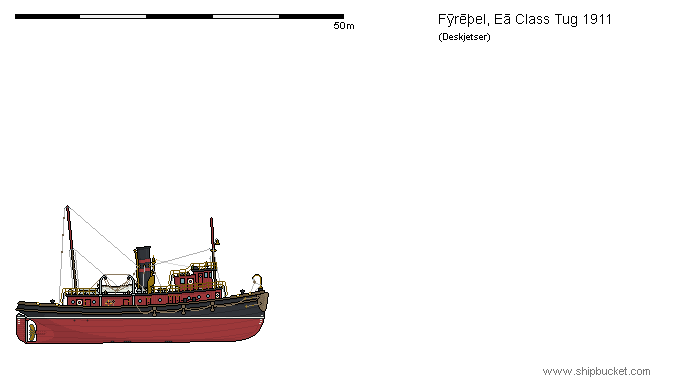Eā Class Sea Tug: Difference between revisions
Deskjetser (talk | contribs) (Created page with "{|{{Infobox ship begin <!-- commercial vessel classes --> |infobox caption=Eā Class Sea Tug, 1911<!-- keywords: yes, nodab; or caption text --> |display title= <!-- keywords:...") |
Deskjetser (talk | contribs) No edit summary |
||
| Line 46: | Line 46: | ||
|Ship ice class= | |Ship ice class= | ||
|Ship sail plan= | |Ship sail plan= | ||
|Ship power= | |Ship power=1700 ihp | ||
|Ship propulsion=3-Cylinder Triple-Expansion Reciprocating Steam Engine | |Ship propulsion=3-Cylinder Triple-Expansion Reciprocating Steam Engine | ||
|Ship speed=11 knots | |Ship speed=11 knots | ||
|Ship capacity= | |Ship capacity=15 t bollard pull | ||
|Ship crew=10-15 | |Ship crew=10-15 | ||
|Ship notes= | |Ship notes= | ||
| Line 55: | Line 55: | ||
|} | |} | ||
The Eā class of tug is the result of a contract from the Stærling Line<ref>(Lit: Starling Line)</ref> (Hereafter: Starling Line), to fill an expanding gap in capability of their current tugboats, as the last decade of competition with the [[Tír_Glas|Glasic] Union Line had seen the average size of ocean liners increase dramatically; Vessels routinely displacing 30,000 tons were now a common sight in the ports of [[Federated_Fire_Territories|Fȳrland]], and so the last generation of tugboats were quickly becoming overwhelmed. | |||
Starling Line awarded the contract for a series of new powerful sea tugs to the Brēcænburg Scipwyrhta Intinga (Hereafter: BSI)<ref>(Lit: Brecanburg Shipwright Company)</ref>, on the 4th of January 1910. The design called for an incredible amount of power to be crammed into the relatively confined space of such a small vessel, with the boiler taking up almost all of the beam amidships; As such, range was considerably limited on high power tasks, while requiring a full complement of five stokers, which made the vessels expensive to operate at full capacity. These characteristics meant that the Eā's operated by Starling Line could often be seen moored alongside the harbour collier, with all hands shovelling coal into the chutes with earnest. | |||
[[File:Eā_Class_Sea_Tug,_1911.png|thumb|left|673px|]] | [[File:Eā_Class_Sea_Tug,_1911.png|thumb|left|673px|]] | ||
Revision as of 09:18, 19 October 2019
The Eā class of tug is the result of a contract from the Stærling Line[1] (Hereafter: Starling Line), to fill an expanding gap in capability of their current tugboats, as the last decade of competition with the [[Tír_Glas|Glasic] Union Line had seen the average size of ocean liners increase dramatically; Vessels routinely displacing 30,000 tons were now a common sight in the ports of Fȳrland, and so the last generation of tugboats were quickly becoming overwhelmed.
Starling Line awarded the contract for a series of new powerful sea tugs to the Brēcænburg Scipwyrhta Intinga (Hereafter: BSI)[2], on the 4th of January 1910. The design called for an incredible amount of power to be crammed into the relatively confined space of such a small vessel, with the boiler taking up almost all of the beam amidships; As such, range was considerably limited on high power tasks, while requiring a full complement of five stokers, which made the vessels expensive to operate at full capacity. These characteristics meant that the Eā's operated by Starling Line could often be seen moored alongside the harbour collier, with all hands shovelling coal into the chutes with earnest.
| Hal and Hadyn |
|---|



